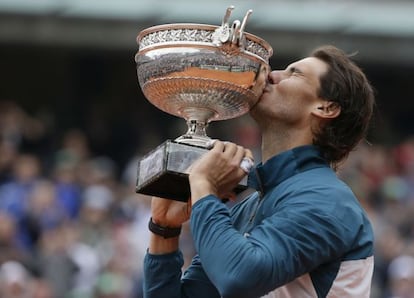Nadal rewrites the history books at Roland Garros
Spaniard claims French Open, becoming first to win same Grand Slam eight times

Neither rain, a court invasion nor the very best that David Ferrer could muster prevented Rafael Nadal from writing a new chapter in the history books in Paris on Sunday. The Spaniard’s straight sets win over his Davis Cup teammate made him the only player in history to win the same Grand Slam eight times, and his 6-3, 6-2, 6-3 victory was his 59th at Roland Garros, another record. Nadal has only been beaten once in nine years on the Paris clay, when Robin Söderling achieved what nobody else had before or since in the fourth round. A record of one win in his previous 16 matches against Nadal going into the final did not bode well for Ferrer.
Indeed, the score line does not really reflect the contest. Nadal was made to work extremely hard by his opponent and by damp conditions in the French capital, which did not lend themselves to the champion’s heavy forehand top spin. Ferrer had not lost a set coming into the final and displayed the resilience that is his own trademark early on when an early break brought up 2-1 and harrowing images of last year’s semifinal, in which Nadal thrashed his countryman for the loss of just five games.
But Ferrer broke back immediately and unveiled part of his game plan in doing so — to attack everything that Nadal left slightly short, go for the lines and come to the net when necessary.
Although Nadal broke again later to claim the first set, the match statistics show something close to parity in break point opportunities — 13 for Ferrer to Nadal’s 16 — but merely carving out the chances is a mammoth task against the Mallorcan in Paris. Ferrer was able only to convert three but even in the second set his tenacity could be measured in numbers. Few 6-2 partials take almost an hour to complete.
Despite the best on-court efforts of Ferrer, it took a masked, shirtless protestor invading Philippe Chatrier to break Nadal’s concentration. The world number four was unable to serve out the second at 5-1 but then regained his composure and added Ferrer’s next service game to the dusting of red brick on the main show court, taking the set with a crushing break to love.
The third began in much the same way as the first, both players exchanging breaks as the drizzle continued.
At 2-3, Ferrer was distracted by a sneeze from the crowd behind him during his service action, staring icily at the perpetrator before displaying sang-froid to hold for 3-3. But that was the last game he would claim as Nadal broke again in game eight to serve for the match. It was the champion’s turn to be unamused when the crowd got a little ahead of itself at 40-15 but a signature thumping serve and forehand combination sent Nadal to the floor for the eighth time on Philippe Chatrier in nine years.
It was the culmination of a comeback from seven months on the sidelines that had been tailored to deliver Nadal to Roland Garros in as close to top shape as possible. If it had seemed the Spaniard would struggle with the five-set format after so long on the sidelines when Daniel Brands relieved him of a pair of sets in round one, Nadal’s epic semifinal with Novak Djokovic was proof that he is back at the peak of his powers.
On clay, whether it be Monte Carlo (eight titles), Rome (seven), Barcelona (eight) or Paris, there is every sense that the ambidextrous Nadal could well try a new trick at this rate: the first player to win the same tournament with his left and right hand.
Nadal must now be considered the greatest clay-courter in history. With 12 Slams under his belt he stands third in the all-time list alongside Roy Emerson, two shy of Pete Sampras. The king of clay should also now be mentioned in any discussion regarding the greatest player on all surfaces.
Tu suscripción se está usando en otro dispositivo
¿Quieres añadir otro usuario a tu suscripción?
Si continúas leyendo en este dispositivo, no se podrá leer en el otro.
FlechaTu suscripción se está usando en otro dispositivo y solo puedes acceder a EL PAÍS desde un dispositivo a la vez.
Si quieres compartir tu cuenta, cambia tu suscripción a la modalidad Premium, así podrás añadir otro usuario. Cada uno accederá con su propia cuenta de email, lo que os permitirá personalizar vuestra experiencia en EL PAÍS.
¿Tienes una suscripción de empresa? Accede aquí para contratar más cuentas.
En el caso de no saber quién está usando tu cuenta, te recomendamos cambiar tu contraseña aquí.
Si decides continuar compartiendo tu cuenta, este mensaje se mostrará en tu dispositivo y en el de la otra persona que está usando tu cuenta de forma indefinida, afectando a tu experiencia de lectura. Puedes consultar aquí los términos y condiciones de la suscripción digital.
Últimas noticias
Maduro pleads not guilty before the federal court in New York: ‘I am still the president of Venezuela’
A new test can detect Alzheimer’s from a finger prick
UN team enters Sudanese city of El Fasher after paramilitary massacre: ‘It’s like a ghost town’
A recipe for resistance: Indigenous peoples politicize their struggles from the kitchen
Most viewed
- Gilles Lipovetsky: ‘If you want to live better and fall in love, take Prozac, don’t look to philosophy’
- Alain Aspect, Nobel laureate in physics: ‘Einstein was so smart that he would have had to recognize quantum entanglement’
- Alvin Hellerstein, a 92-year-old judge appointed by Bill Clinton, to preside over Maduro’s trial in New York
- Why oil has been at the center of Venezuela-US conflicts for decades
- Maduro’s downfall puts China’s relationship with Venezuela to the test








































